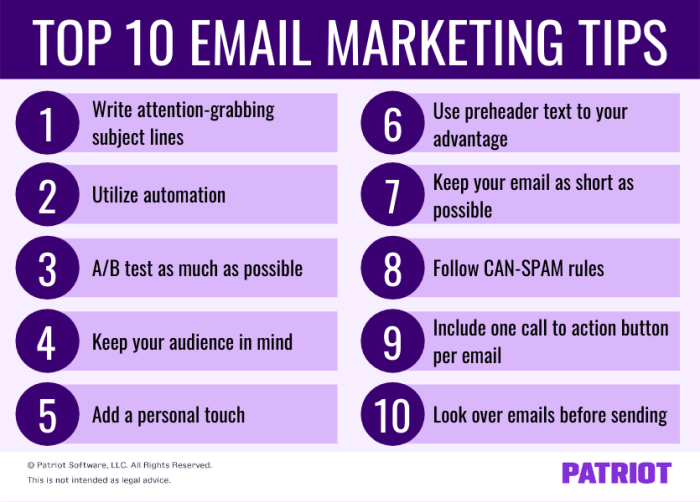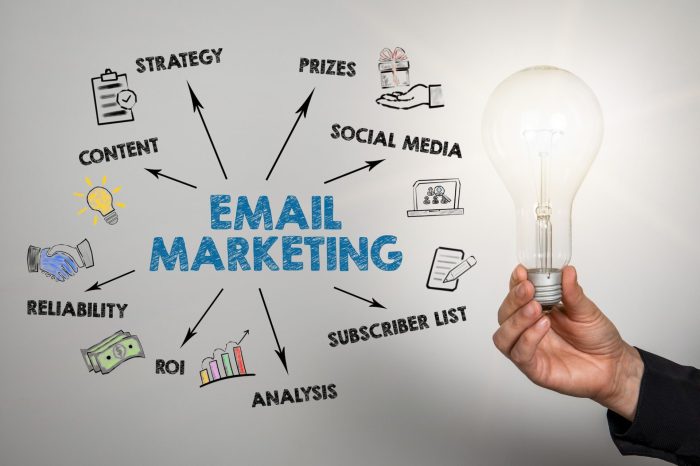Email Marketing Tips, the ultimate guide to enhancing your email campaigns, dives into the world of digital marketing with a fresh perspective that will keep you on the edge of your seat. From building lists to crafting compelling content, this guide has you covered.
Importance of Email Marketing
Email marketing is like the secret sauce for businesses looking to spice up their game. It’s not just about sending random emails; it’s a strategic tool that can work wonders for customer engagement and retention.
Benefits of Email Marketing for Businesses
- Cost-effective: Compared to traditional marketing methods, email marketing is super affordable and can generate a high return on investment.
- Targeted reach: You can tailor your emails to specific customer segments, ensuring that your message resonates with the right audience.
- Builds brand loyalty: By staying in touch with customers through regular emails, you can strengthen your brand presence and keep them coming back for more.
How Email Marketing Helps in Customer Retention
- Personalization: Sending personalized emails based on customer behavior and preferences can make them feel special and valued.
- Feedback loop: Email marketing allows for direct communication with customers, making it easier to gather feedback and improve your products/services.
- Exclusive offers: Providing exclusive deals and promotions to email subscribers can incentivize repeat purchases and foster long-term relationships.
Examples of Successful Email Marketing Campaigns
- Birchbox: The beauty subscription service sends personalized product recommendations and tips to customers, leading to high engagement and conversion rates.
- Uber: Uber’s targeted email campaigns, such as promotions for specific events or holidays, have helped boost customer retention and loyalty.
- Grammarly: The writing assistant tool sends helpful tips and content to users, showcasing the value of their product and keeping customers engaged.
Building an Email List

Building an email list is crucial for any successful email marketing campaign. It allows you to reach out to your audience directly and build a relationship with them over time. Here are some strategies to help you grow your email list organically:
Importance of Segmentation
Segmentation is key when it comes to managing your email list effectively. By dividing your subscribers into different groups based on their interests, behaviors, or demographics, you can send targeted and personalized content that resonates with each segment. This increases engagement and ultimately leads to higher conversion rates.
- Divide your list based on customer behavior, such as past purchases, website interactions, or email engagement.
- Use demographic information like age, location, or gender to create more targeted campaigns.
- Implement segmentation based on interests or preferences to send relevant content to your subscribers.
Creating Engaging Opt-In Forms
Opt-in forms are the gateway to growing your email list. To entice visitors to sign up, your forms need to be visually appealing, easy to fill out, and offer something of value in return. Here are some tips for creating engaging opt-in forms:
- Keep it simple and only ask for essential information like name and email address.
- Offer an incentive such as a discount, freebie, or exclusive content to encourage sign-ups.
- Use eye-catching design elements and clear call-to-action buttons to guide visitors to subscribe.
Crafting Compelling Email Content: Email Marketing Tips

Crafting compelling email content is crucial for engaging your audience and driving conversions. Personalized content in emails can significantly increase open rates and click-through rates. When subscribers feel like the content is tailored to their interests and needs, they are more likely to engage with your emails.
Importance of Personalized Content, Email Marketing Tips
Personalized content helps you build a stronger connection with your audience. By addressing subscribers by their names and sending relevant content based on their preferences and behavior, you show that you value their individuality. This can lead to higher engagement and ultimately, more conversions.
- Use merge tags to personalize emails with subscribers’ names and other relevant information.
- Segment your email list based on demographics, interests, and past interactions to send targeted content.
- Create dynamic content that changes based on the recipient’s behavior or preferences.
Writing Effective Subject Lines
The subject line is the first thing subscribers see, so it’s essential to make it compelling and engaging. A well-crafted subject line can entice recipients to open your email and engage with the content inside.
- Keep it short and to the point. Aim for 50 characters or less to ensure it’s fully visible on mobile devices.
- Use action-oriented language to create a sense of urgency or excitement.
- Personalize the subject line with the recipient’s name or location to grab their attention.
Best Practices for Email Copywriting
Effective email copywriting is all about delivering the right message to the right audience at the right time. Follow these best practices to create compelling email content that drives results.
- Focus on benefits over features to show subscribers how your product or service can improve their lives.
- Write in a conversational tone to make your emails feel more personal and engaging.
- Include a clear call-to-action (CTA) that tells recipients what you want them to do next.
Designing Email Campaigns
When it comes to designing email campaigns, there are a few key elements to keep in mind to ensure your emails are engaging and effective. From creating mobile-responsive templates to incorporating visuals, the design of your emails plays a crucial role in capturing the attention of your audience and driving results.
Creating Mobile-Responsive Email Templates
With the majority of people checking their emails on mobile devices, it’s essential to design templates that are optimized for mobile viewing. Here are some tips to create mobile-responsive email templates:
- Use a single column layout to ensure easy readability on smaller screens.
- Keep your font size large enough to be legible on mobile devices.
- Use buttons instead of text links for a better user experience on touchscreens.
- Test your email templates on different devices and email clients to ensure they display correctly.
Role of Visuals in Email Marketing
Visuals play a crucial role in email marketing by grabbing the attention of your subscribers and conveying your message effectively. Here are some ways visuals can enhance your email campaigns:
- Include eye-catching images or graphics to break up text and make your emails visually appealing.
- Use videos to engage your audience and provide more dynamic content.
- Incorporate GIFs to add a touch of interactivity and capture attention.
- Ensure all visuals are high-quality and relevant to your message to enhance the overall impact of your emails.
Successful Email Design Layouts Examples
Looking at successful email design layouts can provide inspiration for your own campaigns. Here are some examples of effective email design layouts:
- A clean and simple layout with a single focus point to direct the reader’s attention.
- An interactive design that encourages user engagement through clickable elements.
- A visually appealing layout with a good balance of text and visuals to create a compelling story.
- A personalized layout that addresses the recipient by name and tailors the content to their interests.
Email Automation
Email automation is a powerful tool in marketing that allows businesses to streamline their communication with customers, save time, and improve engagement. By setting up automated email campaigns, companies can send personalized messages at the right time, increasing the chances of conversion and customer retention.
Benefits of Email Automation
- Avoid manual tasks: With email automation, repetitive tasks like sending welcome emails, birthday wishes, or follow-up messages can be automated, saving time and effort.
- Increased efficiency: By setting up triggers based on customer actions, businesses can deliver relevant content to the right audience, improving engagement and conversion rates.
- Personalization: Automated emails can be tailored to individual preferences and behavior, creating a more personalized experience for customers.
- Consistent communication: Email automation ensures that customers receive timely and consistent messages, maintaining brand presence and customer relationships.
Examples of Automated Email Campaigns
- Abandoned cart emails: Sending reminders to customers who left items in their cart without completing the purchase.
- Re-engagement campaigns: Targeting inactive subscribers with special offers or content to re-engage them with the brand.
- Lead nurturing sequences: Sending a series of emails to educate and nurture leads through the sales funnel.
Setting Up Effective Email Automation Workflows
- Define goals: Determine the objectives of your email automation campaign, whether it’s lead generation, customer retention, or sales conversion.
- Segment your audience: Divide your email list into segments based on demographics, behavior, or preferences to send targeted and relevant content.
- Create engaging content: Craft compelling emails with clear calls-to-action, personalized messages, and valuable offers to drive engagement.
- Set up triggers: Establish triggers based on customer actions like sign-ups, purchases, or website visits to send automated emails at the right time.
- Monitor and optimize: Track the performance of your automated email campaigns, analyze the results, and make adjustments to improve effectiveness over time.